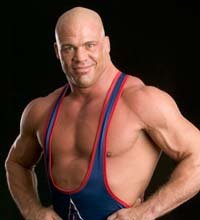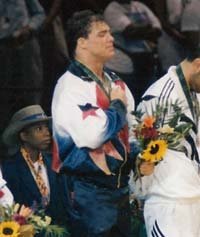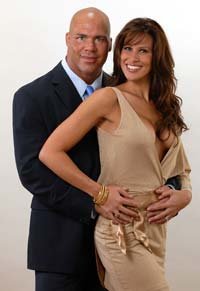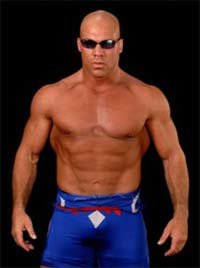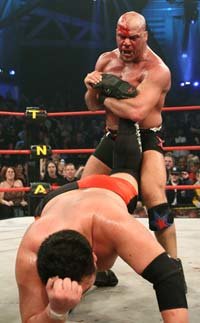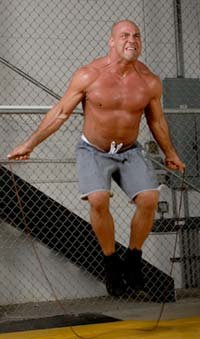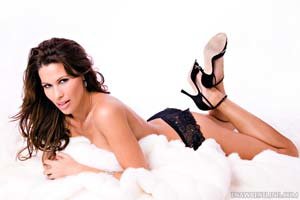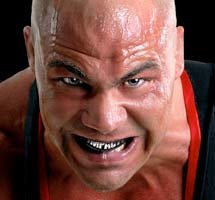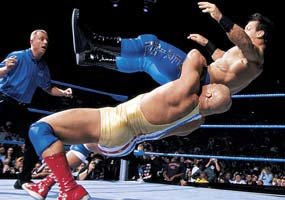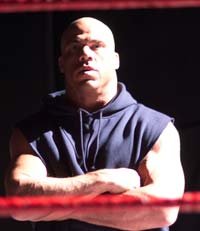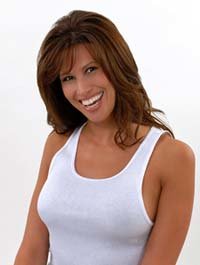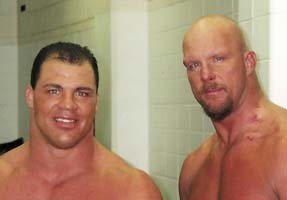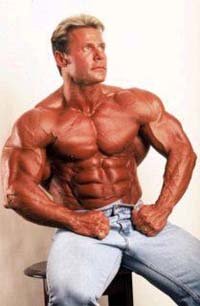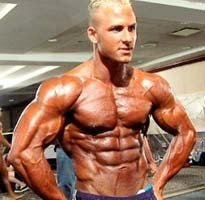The Olympic Hero, The Wrestling Machine, The Olympic Gold Medalist: all names used to describe one of professional wrestling's greatest champions and certainly its most celebrated athlete, Kurt Angle. Angle is the only professional wrestler in history to have won an Olympic wrestling gold medal. It was perhaps only natural for Kurt Angle rise to the top of the colorful and often controversial pro game.
From his days in the WWE (World Wrestling Entertainment) where he won all available titles including World Heavyweight Champion to his current rein as TNA's (Total Nonstop Action Wrestling) biggest and best, being the first man in TNA history to hold all three of their championship titles simultaneously, a strong case could be argued in favor of Kurt Angle being the best professional wrestler of all time.
In high school and college, Angle was involved in many sports, excelling in all, but he was particularly attracted to amateur wrestling. This attraction led to him becoming, among many other titles, a two-time National Collegiate Athletic Association division 1 champion and 1995 World Championship tournament winner.
At the 1996 Summer Olympics in Atlanta, Georgia, Kurt Angle won the men's Heavyweight Freestyle Gold Medal despite suffering a severe neck injury sustained five months earlier at the 1996 Olympic trails, which he also won.
In 1999 Kurt Angle made his first appearance for the WWE and would continue to wrestle for this federation for seven years, often in a role that would see him both universally hated as the bad guy and respected by both fans and fellow athletes as the most technically superior wrestler of his tenure.
Since his switch to TNA, Angle has not faded away as one might expect from a man who has been in the wrestling game for so long, battled debilitating injuries and performed under one of the more grueling WWE contracts which had him on the road 300 days a year. No, true to his claim of being "the best professional wrestler in the world," Kurt Angle, as the current TNA King of the Mountain Champion, remains at the top of his profession.
Another change Angle has made is of the physical kind: he has transformed his physique to where he is leaner and more muscular, which has improved his mat performance and made him even more marketable. Result?
He is now in greater demand for movie and television roles, opportunities he is currently pursuing with a view to broadening professional wrestling's appeal much the same way Arnold Schwarzenegger used his film career to increase public awareness of bodybuilding. The reverse is also true too: Angle has used wrestling, like Arnold used bodybuilding, to crossover to the entertainment industry. Certainly parallels exist between the two athletes.
As with Hulk Hogan (one of Angle's favorite wrestlers), The Rock, and John Cena; Kurt Angle will too make his way onto the big screen.
In this exclusive interview, Kurt Angle discusses his career aspirations along with the truth behind his departure from the WWE, the training program that has transformed his physique and why he feels he is the greatest professional wrestler of all time.

[ Q ] Since September 24, 2006, you have been contracted to wrestle for the TNA federation. Why the move to the TNA? 
- Many reasons - One: over seven years in the WWE, 300 days a year on the road, I was probably the most utilized wrestler because of my past achievements including winning an Olympic gold medal and having the reputation of being the best pro wrestler in the world.
WWE knew keeping me on the road as much as possible would make them the money, but in return it did the same for me. The more I wrestled the more money we both made. It was a situation where if I played the game hard for Vince McMahon he would in return do the same but after seven years it took a toll on me, and my body.
I have a beautiful wife and two wonderful children. I barely saw them and my body really began to break down; most people don't realize I fractured my neck on four different occasions.
I began thinking now is the time for me to start going part time. My manager and I kindly asked WWE to reduce my schedule. The WWE at that point had jumped from two hours to four hours to five hours of programming per week, and they couldn't afford for me to go part time.
Vince McMahon told me, "Kurt, we need you full time." I told him, "Vince, if I can't go part time I'm going to have to quit." And that's where our differences really began.
So I did what I had to do for my family and health, I moved on and went to TNA Wrestling. With TNA I saw a young, rapidly growing company that had an easier schedule that could possibly use a leader like me to help ignite their ratings. Have I ignited it?
To a degree I have my presence in TNA firmly displayed to the wrestling community; this company has some power and deep enough pockets to give WWE a run. Recently they've handed me the ball and now I am their champion with the most titles ever.

[ Q ] How would you explain your job, or position, with the TNA and the WWE? 
- As a professional wrestler my actual job is not to just go out there and beat hell out of everybody. My job is to be a leader. It's to go out and give the TNA fans the very best matches of the night. My job as an entertainer/wrestler is to not just make myself look good but make the talent around me look just as good. This is what I excelled at and what I brought to the table for WWE and now TNA.
For the majority of my career I've been fortunate to be positioned as a main event player, one of the top-tier guys. But what I'm best at is bringing talent from the semi-main events and pulling them up to main event status by wrestling me. Whether I won or lost didn't matter, that was in the writers' hands. What I do best is make my opponent look incredible and that's what I'm the very best at.

[ Q ] So you are raising the bar for those who are less well known as wrestlers by helping them to lift their game. 
- Yes, exactly.

[ Q ] Compared to the WWE, how does the TNA rank in terms of public appeal and what does TNA look for in talent? 
- TNA is averaging between a 1.1-1.5 rating on Spike TV, which is very good on cable, where I believe WWE is doing around a 2.6 but you have to remember TNA is newer and only has one-hour of programming per week, where WWE has five hours between Raw, SmackDown and ECW. With our 1-hour program we've easily matched the ECW ratings and are climbing fast to the SmackDown ratings.
What is great as of this October 4, 2007, is that TNA JUMPS to a new 2-hour program every Thursday night on Spike TV. This new extended time slot is because TNA is growing at an accelerated rate, thank God to the incredible management we have with owner Dixie Carter, Jeff Jarrett and Vince Russo. The 2-hour program finally allows us to give our fans more Real Wresting. We have a slew of talent backstage we can finally bring out to our audience.
If I were to match TNA's talent to WWE's talent, WWE is more fluff with a lot less athletic action. The guys we have at TNA do act but they are 210% more action and more real wrestling. That is what real wrestling fans want. Because of our new time-frame we can now better utilize our top guys (like Samoa Joe, Christian Cage, Abyss, Rhino and Sting) every single week while nurturing our semi-main event talent to become a main event in due time.
At TNA we are looking for the best wrestlers in the business with top athletic skills where WWE has, in the past, looked for the 6-foot-4, 300-pound massive muscle monsters. I am more comfortable at TNA because of my wrestling abilities and this is what made me popular in WWE; it was certainly not my physique.
I do not have the frame or a bodybuilder type look. I'm an extremely well-conditioned athlete, but my frame does not resemble a bodybuilder. I have a blockier build, the perfect core frame for a world-class performance athlete. I'm 6-foot-0, 220 pounds at about 5-percent body fat.
For my sport I need to be in the very best cardio condition of any athlete where I can go 30 minutes to possibly an hour in a match if needed. I try to maintain lean muscle mass and take good care of my body but with high intensity training it's hard to hold on to a lot of muscle.
I am and have always been a wrestler, an Olympic wrestler, that's who I am, that's my job, my description and my passion. A couple of my brothers were former competitive bodybuilders, my brother Eric was actually a NPC national level competitor; my manager Dave Hawk was also a former IFBB pro.
When I was a teen back in '86 watching my brother compete in the Mr. Pittsburgh, Dave had just turned pro and was guest posing with Lee Haney. For one moment I thought about trying bodybuilding but I didn't. It was not for me. The sport of bodybuilding is very tough and I'm a born wrestler so I shouldn't look like a bodybuilder for my sport. Too much muscle on your frame works against your athletic abilities. I do what I call intense cardio - body sculpting to stay in shape.

[ Q ] Then how did you train exactly? 
- Today my training is much different compared to when I trained for the Olympics. Training for the Olympics I trained 28 days out of 30 each month and did lot of
- , which was basically a hectic eight-hour-a-day workout. It consisted of
- and a lot of "core" training.
I did three types of training:
- Track
- Wrestling mat
- Weight training
For example, I would run seven miles a day and kept each mile at approximately seven minutes, I did hundreds of sprints and steps at Three Rivers Stadium, or I would take a 200-pound person or a short phone pole and place a log across my shoulders and run hills, steps or do walking squats for hours.
From there I would hit the wrestling mat for three hours of technique training, and go to gym for 90 minutes and do an intense mix of heavy weight supersets, giant sets and or drop set exercises working different muscle groups on different days but every day I trained was intense.
Now I do more body sculpting with good cardio. This training is not as hardcore as my Olympic days but it's still intense and works well for what I need. I keep my condition up and try to maintain lean muscle so I can have a decent look to my physique. But since I fractured my neck four times, I have some nerve damage through my neck and traps, which runs through my arms.
I actually have to train my upper body, primarily my arms, every other day with pump sets in order to get adequate blood into my arms, neck and traps. My arms are certainly not big but if I don't train them this way the muscle degenerates and shrinks.

[ Q ] You have given me a good overview of what how you used to train. How exactly have you changed your training? Can you go into more detail here? 
- I do not have an exact day-to-day schedule. I train almost everyday doing something, but on day one I train chest, back, triceps and biceps, all in one day, which takes me about an hour. The next day I do my running, where I run three miles and then I go and do three sets of squats with reps from 50-100 on each set with around 225 pounds.
To protect my knees I no longer do leg extensions nor find the need to do leg curls because the squat targets all major lower body muscle groups (quads, hamstrings, and glute's) while also supporting my core.
After my squats I jump rope for about 10-to-15 minutes for my calves. The reason I do that is for my fast-twitch muscle fibers and that keeps me quick in the ring.
After I do my legs and running, the next day I will do shoulders, traps, triceps and biceps, my abs, and that all takes me about an hour. The next day I'm back with a 3-mile run and I do my squats and rope jumping. So what I do is never take a day off. Basically I hit my whole body in three days and then I repeat it again.
Kurt's Weekly Training Program:
Day 1:
- Chest warm-up - (3 sets of each)
Machine Press
Dumbbell Press
Dips
Back (3 sets of each)
Lat Pulls
Dumbbell Rows
Cable Rows
Triceps (2 sets of each)
Machine Triceps Press
Dumbbell Kick Back
Biceps (2 sets of each)
Abs
 Click Here For A Printable Log Of Day 1.
Click Here For A Printable Log Of Day 1.
Day 2:
- between 3 to 6 miles.
- Quads (3 sets of 50-100)
- Calves (15 min)
Jump Rope
 Click Here For A Printable Log Of Day 2.
Click Here For A Printable Log Of Day 2.
Day 3:
- Shoulders (3 Heavy sets)
- or
Traps (3 Heavy sets)
Triceps (3 quick pump sets)
Biceps (3 quick pump sets)
Abs
 Click Here For A Printable Log Of Day 3.
Click Here For A Printable Log Of Day 3.
Day 4:
- between 3 to 6 miles.
- Quads (3 sets of 50-100)
- Calves (15 min)
 Click Here For A Printable Log Of Day 4.
Click Here For A Printable Log Of Day 4.
Day 5:
- Chest w-up - (3 super set of each, reps between 10 to 20)
Incline press
Machine Fly's
Pullovers
Back (3 sets of giant sets)
Machine Cable Rows
Hammer Lat pulldowns
Dumbbell Rows
Triceps (3 quick pump sets)
Cable machine overhead triceps press
- Biceps (3 quick pump sets)
 Click Here For A Printable Log Of Day 5.
Click Here For A Printable Log Of Day 5.
Day 6:
- between 3 to 6 miles.
- Quads (3 sets of 50-100)
- Calves (15 min)
 Click Here For A Printable Log Of Day 6.
Click Here For A Printable Log Of Day 6.
Day 7:
- Rest or

[ Q ] And your recovery has improved with this style of training? 
- Yes, I feel great with this program. Remember I'm not bodybuilding so I do a lot of moderate weights, with higher reps working for a good pump and to keep my conditioning up to go the distance when in the ring.

[ Q ] Is the level of competition harder in the TNA and do you find it more demanding physically compared to the WWE, as far as individual match-ups go? 
- No, TNA is much better as it fits my schedule because I'm only on the road 100-to-150 days a year whereas at WWE I was on the road for almost 300. Wrestling in TNA allows my body to rest and recuperate, which also allows me more time to train properly to prepare for my matches.
An example of the difference at TNA is we have 50 house-shows, 12 pay-per-view and about 38 TV matches per year (100 TNA matches) compared to 280 matches a year at WWE. So my body isn't getting so beat down and I feel 100% better. And for my neck, thank God! TNA's schedule is so much better for my body.

[ Q ] How does this program compare to the training system you used when you were wrestling for the WWE? 
- In WWE I tried to train but it was difficult. I probably only trained three days a week because my media time, ring time and appearance schedule was so hectic. It was also hard for me to find a gym in the different cities. Then when I returned home I was so tired from the two or three weeks in-a-row trip I needed to rest from the travel.
So no, my training was really off and on with them - very inconsistent. WWE's schedule is so rigorous month-in month-out it really burnt the body out!
| FORUM THREAD | ||
|
In TNA I have a more defined and reasonable schedule where I can workout every single day if I choose to. And I make it a priority when I go into a city, even if it's an hour before my wrestling competition, I will go to the gym and get my workout done. Then I will go to the event and I'm warmed up for my match. So it has been much easier for me to train, and it's noticeable that I am in much better shape now than a few years back.
I'm happy to say that now because of my reduced schedule and improved cardiovascular conditioning my body looks better, feels better and if I wanted I could actually do a 3-hour match. I could not say that a little over a year ago when with WWE.

[ Q ] Can you give me an idea of the nutritional breakdown of your current diet? How do you eat for optimal performance in the ring? 
- I'm on a high
- , lower
- , and moderate
- diet. My diet is pretty straightforward. It consists of egg whites in the morning with oatmeal with Sweet 'n Low on the oatmeal. For lunch I have two chicken breasts and large salad. Then I have a protein shake in the afternoon, and then for dinner my wife makes me steak and another large salad, or I might have steamed vegetables, like broccoli, carrots or green beans with some balsamic vinegar with olive oil.
Then at night I have another protein shake. As a night snack for my daughter and myself we'll have some air popped popcorn and have another protein shake. I stay pretty strict on my diet. I probably take in 350-to-400 grams of protein per day with 150-200 grams of carbohydrates and around 55 grams of fat. With this kind of diet, my body stays pretty ripped looking.
| Protein Sources | ||||||||||||||||||||||||||||||||||||
|

[ Q ] What supplements do you use and why? 
- Multivitamin & Mineral - for general health.
- Glutamine - to promote muscle recovery time and support my immune system.
- Creatine - to support strength and muscle energy.
- NO product - to keep nitric oxide levels up to improve blood circulation.
- BCAA's - to improver muscle energy and recovery.
- Enzyme supplement - a protein digestive ad to improve protein uptake.
Limu is a seaweed that you can only find and get from the Island of Tonga. The seaweed is such a part of the island's diet for longevity and health the Tonga government will not even allow ships to go over the seaweed; because they want to keep it clean and pure. When I was addicted to painkillers a few years back, while in the WWE, I was trying to come off the prescription med's and was introduced to Limu. At this time in my life I needed something to help my health and get me through this situation.
I read many testimonials from people who overcame cancer, drug addiction and diabetes, so I tried it and it actually helped wean me off painkillers. I believe in the product. Now I use it regularly to maintain good health and wellness.
Limu improves your body's PH balance while it's also very strong free radical fighter. I hate to say it's a cure for many ailments but it works to balance your body's chemistry. It is the best-kept secret but has also has science to support it. It's an amazing product. I take about eight ounces a day and my body has never felt better. I feel so good now I'm actually considering doing some MMA.

[ Q ] Is competing in MMA competition an option for you right now? 
- Right now a few top
- companies are trying to contract with me for one major fight. At this point my manager Dave Dixie (at TNA) and I are closely considering the IFL as the best option. The IFL seems to have the best field, schedule and opportunity that will also fit my current professional wrestling schedule with TNA.
 |
What Is The IFL? The IFL (International Fight League) is a mixed martial arts (MMA) promotion known as the world's first MMA league. |
 |
 |
||
- As an Olympic champion, 11-time World and Olympic champion, the most recognized and celebrated athlete in the world, they all want me to come in and bring the TV entertainment along with the real athletic skills, because millions of viewers worldwide are going to want to see if Kurt Angle either wins or get his @ss handed to him on a platter. I'm the one recognized Olympic gold medalist and real
- in the business and everyone wants to see if Kurt Angle can really do the MMA. All know I'm going to sell tickets.
I believe I will have a decision for my direction in MMA by mid-November.

[ Q ] If you do MMA, who would you be willing to jump in the octagon with? 
- I would not just jump into a fight with anyone. There are certain guys I won't even consider fighting. There are guys that are very dangerous and I do have a past neck injury these guys know of. If I had to pick a truly quality opponent with similar skills I would consider Randy Couture or someone like him closer to my age and skills background.
Randy Couture is a great guy. I'm proud of his accomplishments. He's a true ambassador for the sport. I actually used to train with him before Olympics and was whipping his butt, (laughs). He's certainly improved since then and is a top guy. So if they want me to fight Randy Couture, the most notorious fighter in the world, I would be happy to fight him, but they have to put up the money and I would need at least three months training to do it.
| FORUM THREAD | ||
|

[ Q ] You won the 1996 Olympic trials and went on to win a heavyweight Gold Medal at the 1996 Olympic Games despite suffering a severe neck injury. How on earth did you manage this? 
- Well, with a lot of prayer and some Novacaine because I wasn't allowed cortisone. I took Novacaine shots before each match so I couldn't feel my neck, which was dangerous because I was risking paralysis, but I went through it to win the Olympic trials and the Olympics, then I retired.

[ Q ] How did you find pro wrestling compared to amateur wrestling? 
- I found out that pro wrestling is much more grueling and barbaric than amateur wrestling, which by the way is the sport in college
- that sees the most injuries. There are more injuries in amateur wrestling than in any other college sports - including
- and
- . So I did go on and do pro wrestling and I found out that pro wrestling is a lot tougher than I thought it was.
When you are in the pro ring you are letting the guys in front of you throw you around half the time. He's throwing you on top of your head and on your back, throwing you out of the ring. It's a stunt show - nothing like real amateur wrestling. I had to learn a whole new industry. And when you learn, then you go above and beyond the call of duty to become the best wrestler in the world.
A lot of guys will claim they are the best wrestler, like Triple-H and Shawn Michaels, but from the fans perspective Kurt Angle was the best pro wrestler ever and I take a lot of pride in that.
My job is to give fans the best matches at every show. And because of that I've accrued hundreds of injuries from my neck down to my heels. There is no other industry like pro wrestling. I was an all-state football player in high school; I was a collegiate 2-time National champion and 1-time runner up; I was a 6-time National champion in wrestling; and a World champion and Olympic champion. Then I went on to pro wrestling and I found that was by far the most grueling business you could ever subject your body to.
I always thought that pro wrestling was fake; it's not fake at all. There are pre-determined winners but the fans do not know the outcome until the match is over; that's what makes it so interesting for them.
As far the pain goes, for at least 30 minutes a night, every night, I'm letting guys throw me on my head, back, shoulders knees and then hitting over the head with a chair. You cannot be in this business without injury and after seven years of day in and day out I had enough and went to Vince McMahon and asked if I can go part time. I was told, "We need you full time, period, we can't afford to have you off."
After a few weeks of not being able to come to a mutually rewarding understanding, I quit (WWE) and went to TNA wresting where Dixie Carter and Jeff Jarrett certainly showed they were there for me. I'm proud to be part of this new exciting, fast growing company that is truly there for their talent.

[ Q ] You say although the matches are scripted, the pain is real. Just how real is the pain when you are in there fighting? 
- Oh gosh! Just getting clothes-lined and hitting the plywood or concrete floor is enough pain for one day, but we go through a 30-minute match where we are doing all of these moves, being thrown on your heads and suplexing one another over and over. You have to remember the ring is metal and wood with very little give. The ring has a little bit of canvas but all-in-all it's a pretty solid surface.
As a professional wrestler when you sign a contract you know what you are getting into. When we see these unfortunate situations like Eddie Guerrero and Chris Benoit, you can't blame Vince McMahon for their personal mistakes and misfortunes. These guys had personal choices.
When they signed the contract they knew how much work was involved. They had the ability to quit any time they wanted. I'm not saying the business shouldn't oversee certain aspects of their talent to make sure they are safe and mentally sound but many misfortunes for wrestlers are brought upon themselves, just as in our society today.
When my life began to unravel with WWE, I could not keep the schedule due to injuries and to stay competitive in the day-in day-out schedule. I decided I had to quit and go with another company that fit me and my health, my schedule and my welfare. I'm now much happier for it; especially for my family and I.

[ Q ] As part of your wrestling training, are you taught how to fall correctly and how to safeguard yourself in the ring? 
- Yes. I was originally trained by wrestling legend Dory Funk Junior and he did a tremendous job showing me all the basic skills. Because of my wrestling background the basic skills worked for me the best as I learned how to sell.
A lot of guys starting try to do too much action and no selling. What I mean by no selling is, they do all this action and then someone will get slammed and they wouldn't sell the slam. They would get right back up and go into another move. That's not the art of pro wrestling. Even if you get hurt and you jump back up and go to another move there's no story being told.
I was taught the proper way: when somebody slams you, you need to sell your back and sell your neck and let that guy take you into another spot where he's trying to go after that certain body part that he slammed you on.
There is a psychology in wrestling and if you get it you'll be very successful with the fans and with selling. A lot of these guys don't get it. They just think that it is a bunch of high spots like flying off the top rope or cage with a bunch of flips and stunts and it's not like that. With pro wrestling there's an art to it. It's not only grueling.
You have to know what you are doing, you have to know how to do it at the right times, listen to the crowd and your opponents. It's almost like a dance. Not like a nice dance, like a grueling dance. And the only two people who know who the winner is going to be are the two people in the ring and that's what makes it so interesting, so intriguing.
The fans don't know who is going to win. I've learned a whole new profession and now I'm trying to teach it to some of the new guys coming up in TNA.

[ Q ] That is really interesting. So you have to make each wrestling match a story and sell it to the fans. Can you elaborate on how you would sell one of your matches? 
- Yes, to get the fans you have to tell a story. If you don't tell the story right the fans won't have an interest in the match. So when I do my matches everything means something.
When I'm wrestling Abyss, a guy around 400 pounds, I'm not going to be able to lift him around the ring. He's the guy who is going to be able to throw me around the ring. So I'm going to have to find a way to knock him down and the only way to do this is dive after his legs, knock him down and make him my size - beat him up and then go from there.
Too many wrestlers depend on high spots and they don't understand the art of the game, which is telling a story to the fans so they can understand it. Whether I win or not, the whole idea is telling an intense fighting story to the fans so they can follow it. If you don't ... it means nothing.

[ Q ] How would you script a fight against a smaller guy like Rey Mysterio? 
- I would have that guy shine on me by doing high altitude moves like diving off the top rope and doing a leg scissor move where he twists me around and hooks me over his back and basically dominates me from a quicker standpoint. Sooner or later I would stop him with one of my trademark moves and then I would beat the hell out of the guy and have the fans cheer him. When it is time to go home, which means finish the match, I would have him doing some high-flying moves because I'm too big for a smaller guy to push me around.
Here he's going to have to dive off the top rope to get me to bump on my back and when he does that he will be successful. Then we can come up with a finish depending on whether he wins or I win. Right now I'm the bad guy so I kind of cheat to win.

[ Q ] What is it like always playing the bad guy? I'm sure you're not a bad guy in real life. 
- No I'm not a bad guy in real life. What I am is a team player and if I have to play a heel and that's what's working with the fan's, then I want to be the best heel for TNA. I want TNA to be successful while taking care of my body and health.
What is unique about my character today is TNA recently hired my wife Karen to work by my side as my sidekick partner. I have to say she has done a tremendous job and has helped the program dramatically. Karen is a very beautiful woman and has a lot of charisma. Because of her great performances she's helped turn me into the bad guy with fans.

[ Q ] Were you ever uncomfortable being the bad guy? 
- Being an Olympic gold medalist it was very hard at the beginning, but after a while I noticed that being a bad guy wasn't so bad. You want fans to either cheer or boo for you. If they don't say anything, they don't care about you.
If they yell and scream at you, they care about you. If they cheer for you they care about you. If they don't say anything then you are in trouble. So far in my career I have either been the top good guy or the top bad guy and doing that the fans have always responded to me and that is a blessing from God.

[ Q ] In the history of professional wrestling there have been many great champions. Do you consider yourself to be one of very best of these champions? 
- There are many great talents in professional wrestling like Triple-H and Shawn Michaels from this era; Gorgeous George from the '60s; Billy Graham and Bruno Sammartino from the '60s and 70's, but as far as being the best ever technically today? I will let the fans say it for me.
This year they again voted for me as the best technical wrestler ever. I believe my success with fans is because I've learned the skills that they enjoy and they know I am the most intense and aggressive wrestler in the business. I am real!
In the past seven years I have won more titles than any other wrestler in history winning 11 world and Olympic titles. And no one has ever done that. Rick Flair has won 16, but he has been a wrestler for 34 years. If I wrestled over that period of time I would probably have 30 titles.

[ Q ] When you were starting out as a pro wrestler, who inspired you to become the wrestler you are today? 
- Hulk Hogan is who I believe to be the most successful wrestler of all time. I have a lot of respect for Hulk Hogan. He's had an incredible career and made a lot of money in the business and has a load of fans worldwide. Also, the Rock and Stone Cold Steve Austin (both great guys and talent), but I've either beaten all of them or made them tap-out at one time or another.

[ Q ] How has professional wrestling evolved over the years? 
- Back in the '60s and '70s during Bruno Sammartino and Bobby Backlund's day wrestling was very old school and much less demanding. Storylines seemed to be built around ethnic backgrounds like, Bruno's Italian background and Bob Backlunds Irish background, and then they brought in some Hispanic.
The matches were slow and deliberate. It was different as it followed some ethnic storyline, but nowadays race doesn't count. Nowadays people pick their favorite wrestlers on skills and performance whether they're Hispanic, black, white, Russian or Japanese. It doesn't matter. It comes down to who is the best performer. Also the matches are much faster and explosive now so it takes a greater skill level to perform.

[ Q ] You mentioned earlier your training and management team. Can you give me some background on your association with Dave Hawk? 
- Dave's been my best friend and manager for many years. He's helped me out tremendously in all aspects of my life from business to training to family. What can I say? Whatever questions or concerns (on any level) I have then I go to him.
When it comes to training and dieting this is a guy who was ranked among the top professional bodybuilders in the world, he knows his stuff. He also has a vast knowledge on the sports marketing and entertainment business while he has opened many doors for me over the past 10 years. He is my closest friend and is looking out for my best interests ... he has my back.

[ Q ] You also had spent sometime training with Dave's son David in amateur wrestling. 
- Yes, when I was training for the Olympics I was also a wrestling instructor. I trained David for a little while before he was a teen and as a teen wrestler. This kid is very talented. He wrestled for about 10 years. Now he is a very successful amateur bodybuilder. I watched him as a kid amateur wrestler and I believe he has the god given talent to expand his skills to professional wrestling.
What could be a benefit for him is that TNA Wrestling does not concern itself with huge monsters but having well skilled athletes; and since he's only 5-foot-9, 215 pounds, I believe his great look and wrestling skills could possibly make him a rising star like John Cena. It's all there!

[ Q ] What do you plan to do after your wrestling career? Any acting aspirations like The Rock and Hulk Hogan? 
- Yes, I'm looking at acting in both film and on TV. I've been told that I have the talent for both action and comedic timing. I personally would like to start with comedy and then do action.
I believe a comedy would be fun and more challenging, not that I wouldn't take an action film; I'm ready to work on a film but it seems athletes are always taken toward action first. I am currently meeting with a casting director for a few projects. We'll see what develops first. The film industry is definitely on my horizon.

